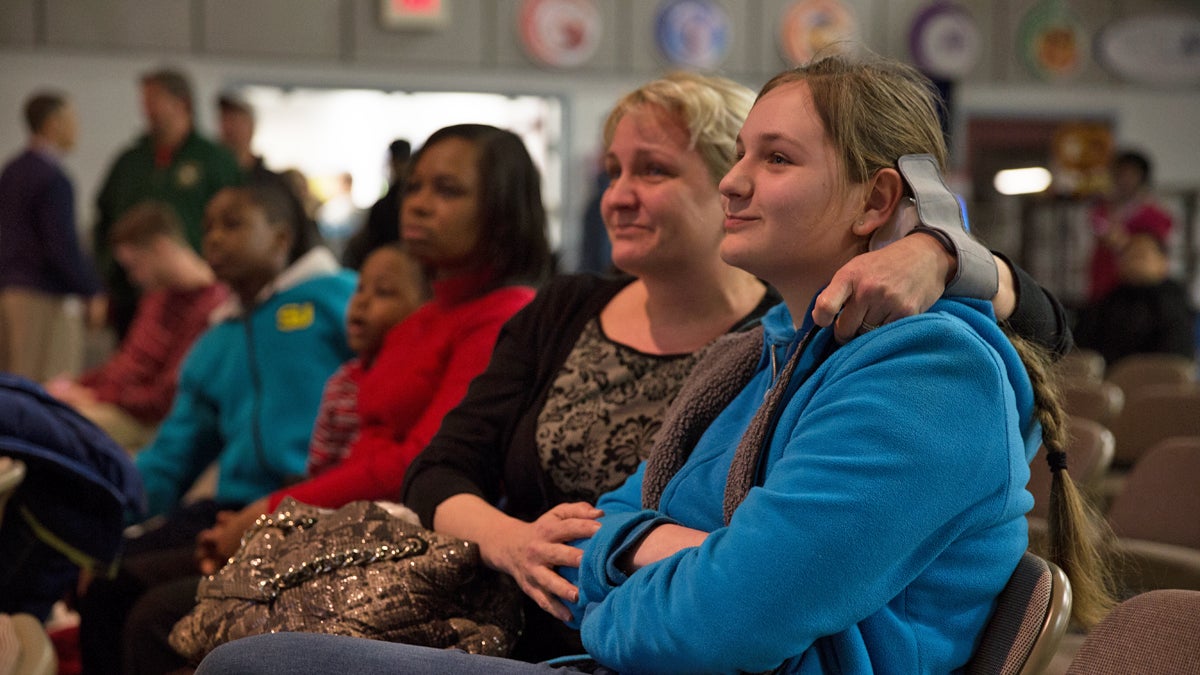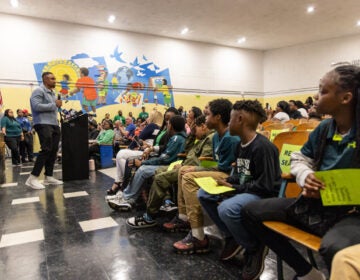Students aching for a spot in top Philly charters sweat out lottery season

Anastasia Ratkova (center) becomes emotional as her daughter, Nicole, 14, is named first on the 9th grade waiting list at MaST Community Charter School. (Lindsay Lazarski/WHYY)
Anastasia Ratkova draped an anxious arm around her 14-year-old daughter. That arm was wrapped in a blood-pressure monitor.
It was the night of the MaST charter school enrollment lottery, and people were anxious. Really anxious.
Mother and daughter sat on folding chairs in MaST’s auditorium on Tuesday, listening as the school administrators randomly pulled 96 of the more than 5,000 names of students who’d applied for admission to the popular and successful charter school in the Somerton section of Philadelphia.
In the state’s new School Performance Profile scoring, MaST (short for Math and Science Technology) earned a excellent rating of 90.0 – the highest score of any city public schools other than the selective-admission magnets.
As Anastasia heard her daughter’s name– Nicole Ratkova– called over the speakers, her heart pounded and tears welled in her eyes.
Nicole had been selected for the top spot on the 9th-grade waiting list – an outcome tied in part to the fact that her younger brother attends kindergarten at the school. Siblings of MaST students get a boost in the lottery.
Waiting list was the best news for which the pair could hope. The only new students MaST admitted in the lottery were those applying for kindergarten. For the 4,219 students hoping to get into grades 1-12, the ride on the wait-list was predetermined. The parents were there to jockey only for order.
Anastasia, a native of Belarus and chemist by trade, later said her blood pressure spiked as she awaited her daughter’s fate.
Afterwards, Nicole, who hopes someday to become a lawyer, flushed with excitement.
“I’m actually really happy. I was really nervous at first, but I’m really, really happy,” she said. “If one person comes out, I’ll be in the school.”
Nicole currently attends another charter school. She spent seven years at St. Christopher’s Catholic elementary school. If MaST doesn’t work out, Anastasia hopes Nicole will be selected in the lottery of another city charter school. The Ratkova family doesn’t consider traditional public schools operated by the Philadelphia School District an option.
“No Philadelphia school district,” said Anastasia in a thick Russian accent, “She will go to Catholic school.”
That decision is driven in large part based – rightly or wrongly – on perception.
“She’s afraid I might change because I was a little reckless when I was small,” said Nicole. “So she’s a little afraid of the kids there.”
Lottery season
As the calendar page gets ready to bluster into March, it will become, in effect, lottery season in Philadelphia, as many charter schools feature similar scenes.
When a student switches from district-run or Catholic school to a charter, the Philadelphia school district incurs a cost, as the state essentially docks the district for the cost of educating the student and sends the money to the charter. This has become a major and controversial drain on the district’s finances.
So the school district declared a moratorium on charter school enrollment expansion.
Not all charters have abided by the district’s requests though. Some have enrolled students beyond agreed-to caps and sent the bill to the state – which then deducts money from the Philadelphia school district’s subsidy, much to the district’s dismay.
District officials maintain that the amount of money the state docks the district for each charter student far exceeds the savings the district realizes from not having to educate the child – to the tune of about $7,000 per child.
In a September commentary published in the Notebook, former SRC commissioner Joseph Dworetzy wrote:
“Despite the enormous amount the District incurs to fund the charter sector, much of that taxpayer money is not going to fund the cost of instruction. Rather, it is funding the ongoing losses that the District must incur because – over many years – it built an infrastructure to support a far greater quantity of students than are currently in District-run schools. The legacy costs of that infrastructure are real and expensive, but at the end of the day the money spent on them is simply lost to the system.”
46 zip codes
This year, MaST says it’s received applications from all 46 of Philadelphia’s residential ZIP codes.
The school draws widespread interest for good reason.
Its students achieve high marks on state standardized tests. It boasts state-of-the-art facilities that include an $7.8 million media center library, a sleek television-production studio and a commitment to STEM education evidenced by an abundance of computers, a 3-D printer, a wind-resistance tunnel and a Nintendo Wii-based fitness center.
Officially, MaST labels itself a “STREAM” school: STEM + Arts and Robotics.
Although MaST receives some resources through private fund-raising, school CEO/Principal John Swoyer says they’re able to afford these things mostly because “we’ve managed the money very well.”
MaST’s non-unionized teachers earn on average “about $10,000 less” than their district counterparts, Swoyer says.
The Philadelphia school district has capped MaST’s enrollment at 1,250 students. MaST would like to grow by an additional 2,550 students over the next five years.
“We’re trying to work with the district to expand properly,” said Swoyer. “That’s a little less than half our wait-list. So, it’s not unreasonable.”
A comparison of MaST’s student demographics (based on most-recently published state data) with those of nearby traditional public schools tells a revealing story:
With an SPP score of 90.0, MaST serves a population that’s 37.06-percent economically disadvantaged, 12.71-percent special education, 1.76-percent English language learner, and 71.97-percent white.
With an SPP score of 54.9, George Washington High School (the comprehensive high school to which Nicole Ratkova would, by geography, most likely go) serves a population that’s 57.7-percent economically disadvantaged, 18.4-percent special education, 10.93-percent English language learner, and 44.64-percent white.
With an SPP score of 79.5, Comly-Watson Elementary (the district elementary school in MaST’s neighborhood in the Far Northeast) serves a population that’s 52.77-percent economically disadvantaged, 12.64 percent special education, 10.67-percent English language learner, and 60.08-percent white.
Overall, 83 percent of students attending district schools are economically disadvantaged.
Despite the fact that MaST’s lottery is open to the public and randomized (aside for that slight thumb on the scale in favor of siblings), the numbers say that, in comparison to the district-run schools, MaST serves a population that’s wealthier, whiter, and lacking in students with learning impediments.
CEO/Principal Swoyer attributes his school’s demographics in part to the sibling preference: “As we get more open seats, I think you’ll see the diversity change.”
David Lapp, staff attorney at the Education Law Center, challenges the notion that MaST should be able to expand. He says charters wishing to grow should first prove that they are serving populations on par with average district-run schools.
“Too often the metrics we use to determine what is a ‘quality’ or ‘failing’ school are merely proxies for the kinds of students those schools serve,” said Lapp. “[MaST] does not serve anywhere close to the numbers of traditionally vulnerable student populations that the average school district school serves.”
Parents hoping their children will one day walk MaST’s beautifully designed halls tend to care less about the city-wide, societal questions that Lapp raises than about this basic issue: Is my kid going to be able to attend a safe, good school.
For Safrana Waldron, mother of four, the headlines and news bulletins about the Philly schools make that prospect seems less and less possible at neighborhood district-run schools.
“That’s what scares everybody the most,” she said, “You hear ‘cutbacks, cutbacks,’ and then you’re like, ‘OK, now you want to find a place different.”
Two of Waldron’s children attend the district-run Fitzpatrick Elementary. Another attends New Foundations Charter. The other is set to attend a still to-be-determined kindergarten next year.
Waldron hoped all four would be selected through MaST’s lottery, but, in the end, found no such luck.
WHYY is your source for fact-based, in-depth journalism and information. As a nonprofit organization, we rely on financial support from readers like you. Please give today.





